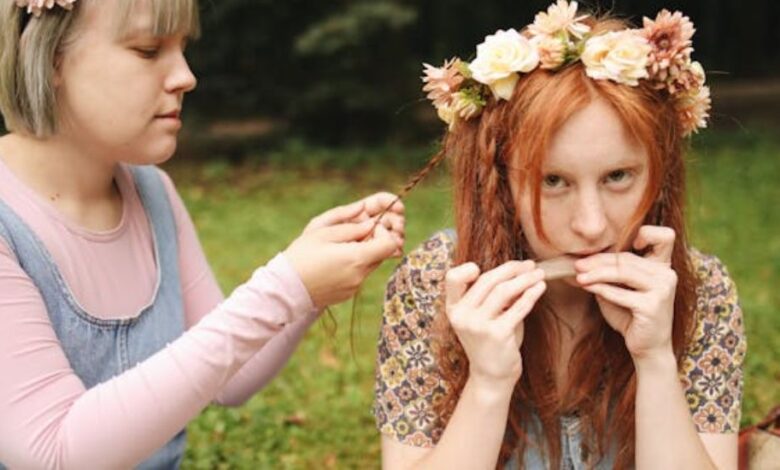60’s fashion trends hippies: The Hippie Revolution

The 1960s were a decade of dramatic social and cultural changes, and nowhere was this more evident than in fashion. The “60’s fashion trends hippies” style became a symbol of rebellion against traditional values and an embrace of peace, love, and individuality. As a cultural movement, hippie fashion rejected mainstream styles in favor of a more relaxed, free-spirited aesthetic that embodied the countercultural attitudes of the time. This article will explore the key elements of 60’s fashion trends among hippies, their social influences, and how they continue to inspire modern-day fashion.
The Origins of Hippie Fashion in the 60s
Hippie fashion emerged from the countercultural movement that was flourishing in the mid to late 1960s. The movement was fueled by a rejection of the materialism, conformity, and war that characterized mainstream society at the time. As a response, the hippies embraced peace, harmony, and a connection to nature. Their fashion was a visual representation of these ideals. Unlike the sharp, structured clothing of the early ’60s, hippie fashion was loose, flowing, and often handmade or second-hand.
Bell-bottom pants, long skirts, and loose-fitting tunics became the norm. Comfort was key, and the hippies’ love of nature was reflected in their choice of natural fibers like cotton, wool, and hemp. The use of bright colors and bold patterns like tie-dye, paisley, and florals was widespread, reflecting the psychedelic culture that was also emerging during this time.
Key Elements of 60’s Hippie Fashion
1. Bell-Bottom Pants
One of the most iconic elements of hippie fashion in the 60s was the bell-bottom pant. These pants, tight around the waist and thighs and flaring out dramatically at the knees, were both comfortable and stylish. Originally a practical design for sailors, bell-bottoms became a statement piece for hippies. They were often worn with platform shoes or barefoot, further emphasizing the movement’s focus on comfort and freedom.
2. Tie-Dye and Psychedelic Prints
Tie-dye shirts were synonymous with the hippie movement. The process of creating tie-dye garments involved twisting, folding, and tying the fabric before applying bright dyes to create unique, colorful patterns. This DIY approach to fashion was another way hippies distanced themselves from the mass-produced clothing of mainstream culture. Psychedelic prints, often inspired by mind-expanding experiences with drugs like LSD, were another hallmark of the time. These prints featured swirling patterns and vibrant colors, echoing the movement’s embrace of nonconformity and freedom of expression.
3. Fringe and Beads
Fringe became a popular embellishment on clothing during the 60s, appearing on jackets, vests, and even skirts. It symbolized a connection to Native American culture, which many hippies admired for its close relationship with nature. Beaded jewelry, headbands, and necklaces were also common, often handmade or collected during travels. These accessories added to the bohemian, nomadic style that many hippies aspired to.
4. Peasant Blouses and Maxi Dresses
Peasant blouses, with their loose, flowing designs and intricate embroidery, became a staple of hippie fashion. These blouses were often paired with long, flowing maxi skirts or dresses. The peasant look was inspired by traditional Eastern European folk clothing, reflecting the hippies’ fascination with other cultures and their rejection of modern consumerism. Maxi dresses, too, were a popular choice, offering both comfort and a free-spirited elegance.
Cultural Influence on 60’s Hippie Fashion
The Peace Movement and Anti-War Protests
The Vietnam War played a huge role in shaping the cultural and fashion trends of the 60s. As the war dragged on, anti-war sentiment grew, and many hippies used their clothing as a form of protest. Items like military jackets, worn with peace signs or adorned with flowers, became symbolic of the rejection of war and violence. The slogan “make love, not war” was often seen on clothing and posters at protests, further cementing the link between the peace movement and hippie fashion.
Music and the Psychedelic Experience
Music was central to the hippie movement, with bands like The Beatles, The Grateful Dead, and Jefferson Airplane providing the soundtrack for this cultural revolution. The psychedelic experience, often enhanced by drugs like LSD, influenced not only the music but also the fashion. Bold, colorful, and often chaotic patterns mirrored the mind-altering experiences that hippies sought through music and drug use. The iconic imagery from music festivals like Woodstock in 1969, where thousands of young people dressed in flowing, colorful clothes, became the lasting image of the era.
The Influence of Eastern Cultures
The fascination with Eastern philosophy, particularly from India and other parts of Asia, greatly influenced hippie fashion. Items like kaftans, sarongs, and other traditional garments from these regions were adapted into the hippie wardrobe. The practice of meditation and yoga, which became popular during this time, also influenced the loose, flowing garments that allowed for freedom of movement and comfort.
The Legacy of 60’s Fashion Trends Hippies
The impact of 60’s hippie fashion continues to be felt today. The emphasis on individuality, comfort, and sustainability has made a lasting mark on the fashion world. The bohemian styles of the early 2000s, with their flowy dresses, fringe details, and earthy tones, were directly inspired by 60’s hippie fashion. Even in contemporary fashion, the focus on eco-friendly clothing and the resurgence of DIY trends like tie-dye can be traced back to the hippie ethos of the 60s.
Hippie fashion also laid the groundwork for the casual styles that dominate modern wardrobes. The rejection of formality in favor of comfort, seen in the widespread popularity of jeans, t-shirts, and casual dresses, has its roots in the 60’s fashion revolution. Additionally, the political and social movements associated with hippie culture, from environmentalism to LGBTQ+ rights, have continued to influence fashion as a form of personal expression and activism.
Conclusion
The 60’s fashion trends hippies embraced were about more than just clothing—they were a symbol of a broader cultural movement that rejected conformity and celebrated freedom, individuality, and peace. From bell-bottoms to tie-dye, fringe to maxi dresses, hippie fashion challenged the status quo and set the stage for the more relaxed, individualistic styles that dominate fashion today. As we look back on the 1960s, it’s clear that the era’s fashion was a key part of a larger cultural shift, one that continues to inspire and influence the way we dress and express ourselves today.



